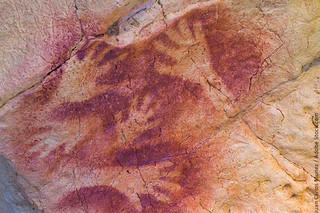An interdisciplinary research team from the University of Cologne’s Institute of Geophysics and Meteorology and the Department of Prehistoric Archaeology has developed a new model, the “Our Way Model”. They modelled the movements and population densities over time and space during the Aurignacian (approximately 43,000 to 32,000 years ago) to better understand how the first anatomically modern humans populated Europe. The model reveals four phases of the process. The first phase saw a slow expansion of human settlement from the Levant to the Balkans, followed by the second phase of rapid expansion into western Europe. The subsequent third phase was characterized by a decline in human population, and the fourth phase brought regional increases in population density and further advances into previously unsettled areas of Great Britain and the Iberian Peninsula. The results have been published under the title ‘Reconstruction of human dispersal during Aurignacian on pan-European scale’ in Nature Communications.
The interdisciplinary collaboration between climate scientists and archaeologists enabled the team to examine how climate change influenced human dispersal quantitatively. Early anatomically modern humans survived as hunter-gatherers for extremely long periods. When they started spreading across Europe, global climatic conditions were different from today: The prevailing cooler and drier climate of the late Last Glacial Period was repeatedly interrupted by warmer interglacial periods, with some changes occurring abruptly and others gradually.
Reasons for human dispersal to Europe were likely diverse, including human exploratory spirit, evolution in social structure and progress in technology. The newly developed model, however, allowed the research team to clearly demonstrate how climate change impacted human dispersal. Previous numeric models of long-term dispersals of human populations on continental scales commonly relied on so called diffusion-reaction equations, i.e., a combination of slow, continuous dispersal in all directions driven by the constant reproducing and growing population. Agent-based models focusing on individual or group motivations of humans to migrate, in turn, are more popular on smaller scales. Recent new models feature data from paleoclimate models in their calculations, but focus on Net Primary Production, an indicator for the amount of stored CO2 in plants and animals, as a proxy for food availability and human mobility. The disadvantage of this approach is that it does not consider the accessibility and availability of these food sources, as only a fraction of them were usable by humans.
The research team assumes that early habitation in Europe involved highly complex processes of advance, retreat, abandonment and resettlement, driven by climatic changes as well as humans’ ability to adapt. The “Our Way Model” simulates human dispersal in two main steps: first, combining climate and archaeological data to model the Human Existence Potential (HEP), and second, modelling the human population dynamics constrained by the HEP. HEP defines the likelihood of human existence under climate and environmental conditions for a given culture. This vital quantity is estimated using an HEP model that takes into account paleoclimatic data for known archaeological sites. This machine learning approach constructs the climatic constraints for the Aurignacian culture, estimating which climate conditions humans of that culture preferred to live in. The trained model is then applied to estimate the spatial and temporal HEP patterns using data simulated by the so-called Global Climate Model as well as oxygen isotope data from Greenland ice cores.
The results showed that a first phase of relatively slow westward expansion from the Levant to the Balkans (approximately 45.000 to 43.000 years ago) was followed by a second phase of rapid expansion into western Europe (approximately 43.250 to 41.000 years ago). Although interrupted by brief setbacks, Homo sapiens populations now rapidly reached an estimated number of 60.000 people across Europe, spread across all the known archaeological sites during this period. The subsequent third phase was characterized by a decline in the human population, both in terms of its size and density as well as the area occupied by the population (41.000 to 39.000 years ago). This development resulted from a prolonged severe cold period which lasted almost 3.000 years, known as the GS9/HE4 period. However, according to the model, humans survived in the climate shadows of large topography (e.g., the Alpes), which they had just occupied in the previous phase. In the fourth phase, when HEP conditions improved again, the population quickly recovered and grew further, starting at around 38.000 years ago. Regional increases in population density and further advances into previously unsettled areas of Great Britain and the Iberian Peninsula, which the model showed, are broadly in line with the archaeological evidence.
The HEP maps indicate that at the end of this process, parts of the human population were better adapted to cold climatic conditions than others, allowing them to push the boundaries of previously settled environments. “Regional studies can hardly capture all factors at play when trying to reconstruct human dispersal, including how they work together at different scales and contribute to overall long-term trends. This is a major advantage of the new modelling approach”, said Dr Isabell Schmidt at the Department of Prehistoric Archaeology.
In further research, the team will test the underlying assumptions made in the model, focusing on the role of cultural evolution in the human dispersal process. The project Human and Earth System Coupled Research (HESCOR) at the University of Cologne will integrate further aspects of Human-Earth system interactions into the model.
Media Contact:
Professor Dr Yaping Shao
Dr Christian Wegener
Institute of Geophysics and Meteorology
+49 221 470 3688
yshaouni-koeln.de
c.wegener@uni-koeln.de
Dr Isabell Schmidt
Department of Prehistoric Archaeology
49 221 470 3385
isabell.schmidtuni-koeln.de
Press and Communications Team:
Eva Schissler
+49 221 470 4030
e.schisslerverw.uni-koeln.de
Publication:
https://www.nature.com/articles/s41467-024-51349-y
DOI: 10.1038/s41467-024-51349-y
More Information:
https://hescor.uni-koeln.de
